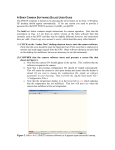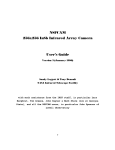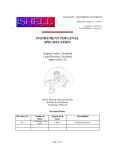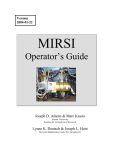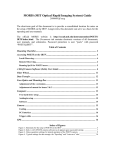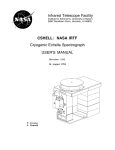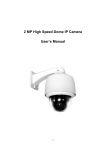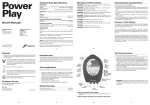Download IRT-1 User Manual.docx
Transcript
IRT-1 User Manual Thank you for purchasing the Brooks Technology IRT-1 Talking Infrared Thermometer. We hope you enjoy many years of use with the IRT-1! General information The IRT-1 was designed primarily for use by the blind and poorly sighted. It’s primary usage is envisioned as a cooking aid, but there are many things you will find that it can be used for. This is a valuable tool for people with peripheral neuropathy, a condition often associated with blindness and other neurological conditions. How to operate the IRT-1 There are 3 buttons on the device, Temperature, Scan, and Mode. There is an infrared sensor located at the front of the unit, on the side above the speaker. ● Startup: The IRTF-1 comes with two fresh alkaline batteries installed. To activate the unit open the battery door (at the back of the unit) and remove the ribbon that insulates the battery connection. Replace the battery door. At this time you will hear a prompt to press any button to start the introduction. A brief spoken tutorial will follow. To hear it again, simply remove and replace one of the batteries.. ● Reading temperature: To read an object’s temperature, aim the device at the object and press the temperature button. The detected temperature will be read out. The infrared sensor had a wide field of view. If you are 1 foot away from an object, then the device will measure and average the temperature of an area that is approximately 1 foot in diameter. Since it is designed with cooking in mind, this is not typically a problem. Attempting to measure temperature of distant objects won’t give an accurate reading. ● Scanning for hot items: The scan button is the middle button. The scan function is designed specifically to help the vision impaired locate hot objects, such as the burner on a stove. This is useful for centering a pan or pot over a burner, especially for owners of flat cook top stoves. Without being able to see, it is virtually impossible to be certain your pan is over the burner! The scan function emits a slow beeping sound, and it becomes a very rapid beeping as you near the hot object. You can use this to locate the burner, prior to placing a pan on the stove. As always, exercise caution with these procedures, and start with the burner settings on low. Do not get the IRT-1 too close, excessive heat may damage the case and or sensor. Be sure to hold the IRT-1 vertically during a scan. If you hold it at an angle you cannot accurately locate the source of heat. Another method to center a pan over a burner is to start by placing the pan over a warm burner, then scan for a hot edge. Example, the pot is on the burner, but the rear area of the burner is slightly exposed. Using the scan function, you should be able to detect more heat coming from that area, than from other areas. The scan function can be used to verify that the stove is off and cool as well, before leaving the kitchen. ● Changing readout or language: The Mode button is located at the end of the device. Once pressed (you will hear very brief instructions from the device) you can change from fahrenhite to centigrade, or the language from english to spanish or french. Example: Press the mode button. Listen to the instructions. Press the temperature button, you will hear the device speak fahrenhite or centigrade. When you hear the readout mode you want press the Mode button a second time. You can also change language in a similar fashion: Press mode, listen to the instructions, press the scan button to hear the language you want, then press mode again. Batteries. The IRT-1 uses two AA batteries, which are accessible at the back of the unit. A small cover easily pops off by pulling on the tab. Batteries are held in place by a typical spring loaded arrangement. Battery life, depending on brand and condition should provide 6 months to a year of use. Use only alkaline batteries. Do not use rechargeable batteries, their output voltage is too low for this device. For more detailed usage tips on the IRT-1 please visit brooks-technology.com. FCC Compliance Statement: This equipment has been tested and found to comply with limits for a Class B digital device, pursuant to Part 15 of the FCC rules. These limits are designed to provide reasonable protection against harmful interference in residential installations. This equipment generates, uses, and can radiate radio frequency energy, and if not installed and used in accordance with the instructions, may cause harmful interference to radio communications. However, there is no guarantee that interference will not occur in a particular installation. If this equipment does cause interference to radio or television equipment reception, which can be determined by turning the equipment off and on, the user is encouraged to try to correct the interference by one or more of the following measures: ● Reorient or relocate the receiving antenna ● ● ● Move the equipment away from the receiver Plug the equipment into an outlet on a circuit different from that to which the receiver is connected Consult the dealer or an experienced radio/television technician for additional suggestions You are cautioned that any change or modifications to the equipment not expressly approve by the party responsible for compliance could void Your authority to operate such equipment. This device complies with Part 15 of the FCC Rules. Operation is subjected to the following two conditions 1) this device may not cause harmful interference and 2) this device must accept any interference received, including interference that may cause undesired operation. Brooks Technology www.brooks-technology.com


